My clinical interest is longevity, which is a function of lifespan and healthspan; In math parlance, longevity = f (lifespan, healthspan). Lifespan is pretty easy to define. It’s the number of years you live. Healthspan is intuitively obvious, but a bit harder to define. For simplicity, let’s agree that healthspan is a measure of how well, not necessarily long, you live. Further, let’s agree that one without the other—long lifespan with poor healthspan or short lifespan with rich healthspan—isn’t what most people want. This has the makings of a complex, nonlinear, multivariate optimization problem.
The figure below is from my office whiteboard last week. I was explaining the relationship between lifespan (x-axis) and healthspan (y-axis) to one of my patients. My goal is to move the black line to the blue one. Live longer (more x-axis) and live better (altered shape of decline curve).
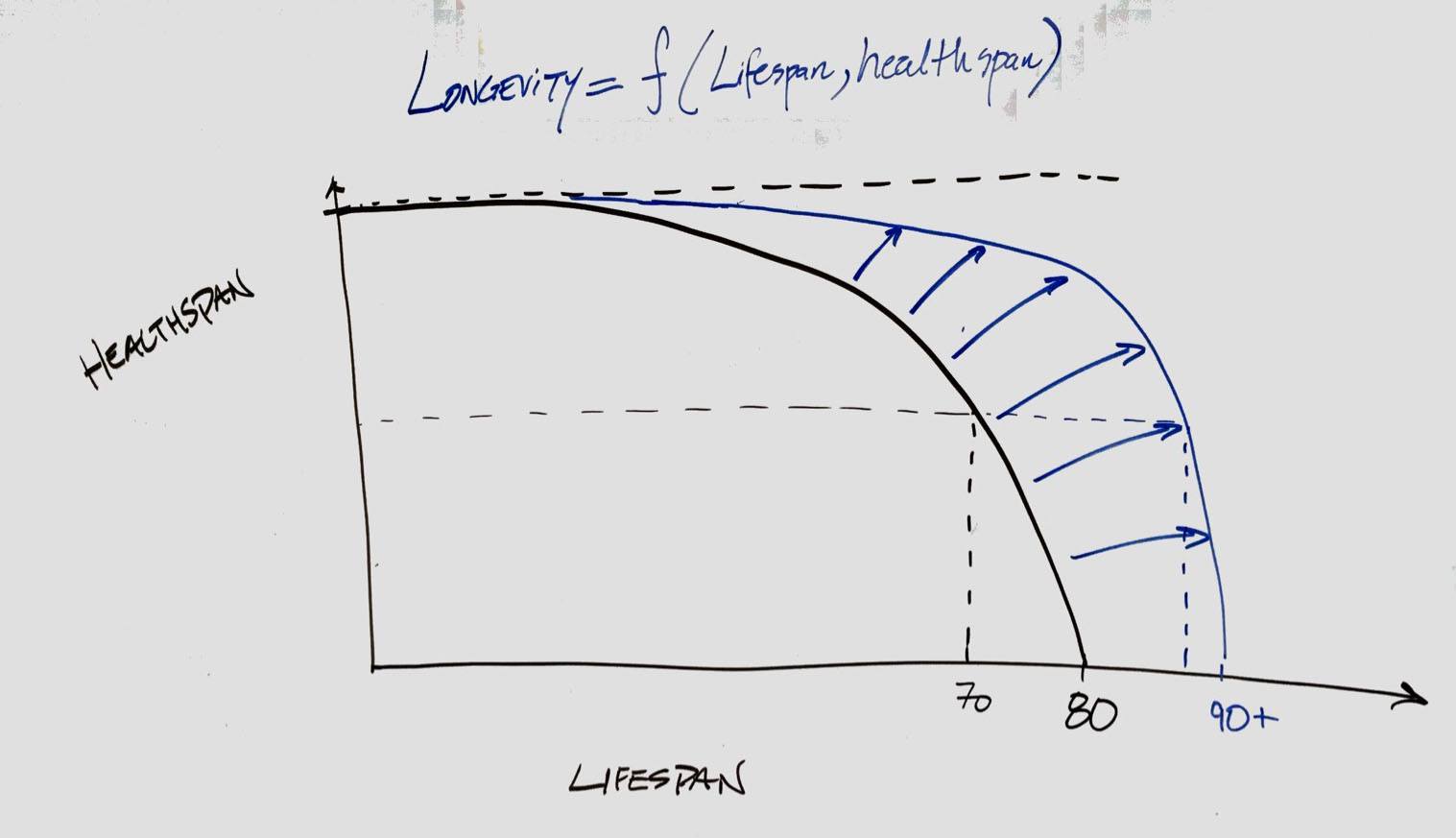

I’m in the (very slow and time consuming) process of writing a book on this topic, which is really two books in one—the science of longevity and the “art” of it, the latter being a nuanced discussion about how one applies said science (most of it in animals) to the species of interest—people. If you don’t spend much time in the longevity literature, this distinction may not seem warranted. If you do spend time in said literature, it will be obvious why such a distinction is necessary.
Lifespan, at the first order, is driven by how long one can delay the onset of atherosclerotic disease (CHD, CVA), cancer, and neurodegenerative disease. Delay the onset of these, and you live longer. It’s a probabilistic truism. Obviously, I will explain this in great detail at the appropriate time, but I don’t want to focus on this topic today.
Healthspan, in its most distilled form, is about preserving three elements of life as long as possible:
- Brain—namely, how long can you preserve cognition (i.e., executive function, processing speed, short-term memory)
- Body—specifically, how long can you maintain muscle mass, functional movement and strength, flexibility, and freedom from pain
- “Spirit”—how robust is your social support network and your sense of purpose
In this post, I’d like to focus on one subset of healthspan: item #2—movement. But before I do, a brief digression will be helpful.
The hack—Darwin meets MacGyver
Evolutionary biology can, at times, provide a helpful framework for longevity. Our need for sleep and our resilience to short-term food deprivation are just two examples of traits that served our interests tens of thousands of years ago and continue to do so today. Some of the interventions that can make you live longer and live better will find their foundation in understanding evolutionary biology. But many won’t. That is, many things I (and others) argue are necessary for longevity don’t really have an obvious foundation in evolutionary biology. Why?
Enter “the hack.”
A hack is something we do that gets around a problem, even if it’s not especially elegant. A patch might be an easier way for some to understand what I mean (cf. software patch). The hack can be elegant, the hack can be cumbersome, but its purpose is the same—something is getting in the way of a desired outcome and we need a workaround.
When I talk with my patients I try to differentiate interventions I propose as “evolutionary sound” or as “hacks.” Inasmuch as this framework is helpful, let me expand.
Our evolutionary ancestors were primarily concerned with survival. There was no survival more important than reproductive survival—ensuring you lived long enough to reproduce. Natural selection would prioritize short-term survival over long-term survival or quality of life. [As a very interesting, but too-nuanced-for-now aside, the evolution of APOE genes from the E4 to E3 to E2 variants may be great examples of this…yes, this will be discussed in the book, space permitted.]
Take stress response as an example. The stress response was an essential part of evolution. Without it, fending off an animal trying to attack you, or hunting for food in a state of starvation would not have been possible. Nothing about our evolutionary development selected for, or rewarded, equanimity. Our ancestors probably did not have the luxury of inner peace. It’s also not clear if it would have been necessary, or even helpful. But I argue that our current environment places sufficient non-evolutionary stress on us, and, as such, a hack that separates us from this stress is, indeed, helpful. Furthermore, we now have the luxury of aspiring to things our ancestors could never dream of. They were preoccupied with reproducing and not dying; we aspire to play with our great grandchildren, we machinate on our legacies, we argue about if the Oscars are really inclusive enough.
Years ago, when I read Jared Diamond’s magnum opus, “Guns, Germs, and Steel,” I remember thinking to myself how horrible it must have been to have lived even as recently as just a few hundred years ago, let alone a few thousand years ago. It really had a profound impact on me, though it was not the central thesis of his book at all. I realized that on my “worst” day—lost my cell phone, got a speeding ticket or had a fender bender, missed my flight, got food poisoning from some bad sushi—it didn’t really matter. Technology and civilization took a bunch of really acute problems—lethal infections, starvation, trauma, war, for example—and traded them for more chronic ones—lower back pain, heart attacks, type 2 diabetes, and Alzheimer’s disease. I’m not minimizing the latter. These problems matter, but evolution didn’t confront them and therefore we can’t readily turn to evolutionary insights for solutions. Parenthetically, it might not have been as miserable as I imagine, namely because our ancestors didn’t know any better. It’s not like they would have “missed” Tweeting on their smartphones or racing around on their carbon fiber bikes, lamented the loss of their favorite sports team, or missed the pleasure of sipping neat Don Julio 1942.
Think about what Peter Parker’s uncle said to him shortly before he was killed, “Remember, with great power comes great responsibility.” I think of our modern lives as a great power, or a great privilege, to be more accurate, I suppose. I would never want to go back and live as my ancestors did tens of thousands of years ago (or even a hundred years ago, though it might make for a nice vacation) and so I should pause for a moment and acknowledge the complete privilege of living today in this incredibly narrow sliver of time. I love the internet. I love that agriculture and crop domestication have allowed me to live in civil society with dense populations and no fear of starvation. I love that a simple antibiotic can save my life from a formerly lethal infection. I love being able to sit down in a car or airplane, and I love the freedom those machines have brought me.
So if these examples of things I love are some of my great privileges, what are my great responsibilities? This is where hacks come in. We need hacks to prevent these great privileges from killing us—slowly—which they will do if we’re not deliberate. What are my hacks? A bunch of things that make virtually zero evolutionary sense but, if bolted onto my modern life, can give me—if I can thread the needle correctly—the best of both words.
Meditation, intermittent fasting, heavy compound joint and hip-hinge training, intense interval training, body work, supplements, drugs, introspection, sleep hygiene. These are my hacks. Let’s focus on one hack, in particular—movement preparation.
The savant of movement
I met Jesse Schwartzman through a mutual friend. After our first workout together I was blown away, but it wasn’t the workout that impressed me, it was the preparation routine Jesse put me through, prior to making me puke, that impressed me. I’d never felt more ready to move. Jesse’s formal bio is at the bottom of this page, but I just call him the savant of movement. One day Jesse and I were having coffee and he commented at how annoyed he was by the endless stream of “heroic” tweets and IGs of super-humans doing one-armed acrobatics or whatever the stunt of the day is. He commented, astutely, I noted, that the world needs another super-human trying to convince the rest of us we should be like him/her like it needs another dictator.
What we actually need are examples of how real people can be empowered to preserve muscle mass, move functionally, maintain freedom from pain, and be the best athletes of their lives. An “athlete-of-life” can hip-hinge, squat, carry, shift, push, pull, rotate, and anti-rotate with confidence and fluidity. On a deeper level, one should also re-connect to their childhood movement patterns, before the toll of life and technology wreaked havoc. We need to re-learn how to roll, crawl, and hang, which are patterns that can release the “brakes” from our everyday movement that sabotage strength and lead to pain and injury.
Watch a 2-year-old squat and you’ll know what I mean. They look like perfect little power lifters. By the time they are in grade school, and they’ve been sitting for hours a day, the first thing I see is tight hips. [Picture below courtesy my friend Pat Jak, also obsessed with correct movement.]
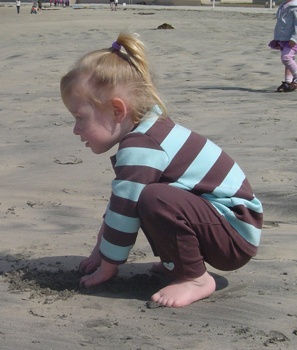
To that end, we decided to make a video of the exact warm-up sequence Jesse put me through so I could share it with my patients. If they (and you) find this video helpful, we’d like to produce more of these covering more specific topics, such as how to protect/ build/ rehab knees/ shoulders/ lower back, etc.
Before diving into the videos, I know at least one person is reading this and thinking, “What the hell is Attia talking about? He’s the king of doing stupid stuff like flipping 450-pound tires, swimming 12 hours, doing Tabata deadlifts…” And you’d be right. I do/did a lot of stupid stuff. But I always differentiate the stupid (“super-human”) stuff I do from the longevity drivers. My pet peeve, and that of Jesse, is that good people are misled by the heroics of big-personality super-humans who lead them to believe they need to do these things to live better. In reality, it’s almost always the opposite. You don’t have to do super-human feats to have great healthspan and, by extension, longevity. But you do have to do some very deliberate things to overcome our civilized environment. So while I call Jesse the savant of movement, he prefers to call himself the anti-super-human teacher.
Below are four videos, a brief introduction, and one video for each of the three stages of the warm-up:
- Tissue preparation
- Muscle activation
- Dynamic preparation
In addition, we’ve put together a “tear sheet” for each of the three stages in case you want take them with you to the gym until you commit to memory.
I should point something out, since I know it will come up. With the recent publication of Tim’s book, Tools of Titans, I’ve been getting a lot of requests to make a video of my so-called “Jane Fonda” routine. In Part II of the videos, below, I do a glute med activation exercise, but it is not the full sequence I describe in Tools. That’s ok…the form that Jesse and I demonstrate, coupled with the description in the book, should be sufficient to get you through the full routine of seven movements. For the purpose of movement preparation, one only needs a bit of activation (hence the vertical plane, only). What I describe in Tools is a therapeutic routine I perform once or twice each week.
Lastly, and most importantly, I want to thank Elliot Stern and Kelly Choi for shooting, producing and editing these videos from start to finish. If you could only see the outtakes…
Introduction
Here is direct link: https://youtu.be/ZVUQb2G_Mvw
Here is link to tear sheet, summarizing all three parts
Part I: Soft tissue preparation
Here is direct link: https://youtu.be/zdRgJpxifqA
Part II: Muscle activation
Here is direct link: https://youtu.be/JElEpnVH35Q
Part III: Dynamic preparation
Here is direct link: https://youtu.be/BGrw5z1SjtA
Jesse Schwartzman, MS, RD, ACSM CPT, holds a Master’s Degree in Nutrition and Applied Exercise Physiology from Columbia University, and is a Registered Dietician. Jesse, along with his wife Patty, currently owns and operates Fit4ward in NYC and the greater Fairfield County, CT, where he manages and engages in deeply personalized work with his clientele in all aspects of health.
Early on in his career, the importance of adopting lifestyle behaviors to support exercise and nutrition goals became a fundamental focus of his work. Joint mobility and tissue health, proper fascia and nervous system regeneration, fueling techniques, sleep and recovery, identifying asymmetries, and proper neuromuscular motor patterns are incorporated with every individual.
Jesse now has over 10 years of experience in the health and wellness industry in one on one personal training, nutritional counseling, health coaching, group workshops, and the corporate setting. Jesse previously trained clients at the highest certification level at Equinox Fitness Clubs, and managed Equinox’s most elite trainers and exclusive clientele in the Tier 4 Program at the “E” club.
Photo by Hidde Rensink on Unsplash


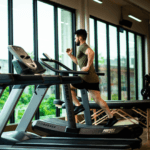
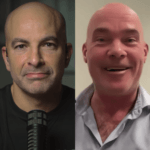

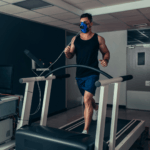
I am curious about what you think of the Blue Zones? Seems to be a very proven way of eating and living well into your 100s for some! There is so much confusing information out there about food and to your point about your wife (an older post) being able to eat sweets and not affect her, I wonder if some folks can eat larger amounts of meat and not be affected (although be atypical much like a sweet eater who never gains weight). I’ve heard of certain tribes in Africa who can eat mostly meat and be healthy but have they genetically adapted to thrive on the local food sources?
Hi Peter and Jesse and thanks for the great article !
I found your ”Jane Fonda” protocol 2 weeks ago in ”Tools of Titans” and started to try it.
Since half an year i have ITB issues which made me stop running in the last 2 months.
I understood that the above protocol helped you a lot with your knees. Would you recommend ”Jane Fonda” protocol as rehab for ITB syndrome and if so, how often would you suggest to perform it ?
Or do you have some other recommendations for ITB ?
Thanks a lot and looking forward to read your book !
That was wonderful! Thank you both
I think one thing missing from this article is the fact that this will require a little bit of deliberate practice before you can do it in 10 minutes on autopilot before the workout.
Absolutely!
Another outstanding contribution to this seemingly never-ending quest for longevity. Thank you, sir.
I have a relatively mild form of Ehlers Danlos Syndrome, would you guess that these techniques would be less beneficial, more beneficial, or the same? My joint hypermobility is lessening with age (I’m 31), so I no longer dislocate joints; but I assume my myofascia are already loose given my hyperelastic skin and muscles pretty much hang off of my bones when relaxed. Thoughts?
More beneficial I would argue. This sequence is about getting your prime movers to do the work (rotating and stabilizing) instead of mobilizing helper muscles that often cause us pain (like hip flexors, lower back, TFL) Pay close attention to keeping a neutral spine and not rotating from your lower back.
This is great. I just purchased a Trigger Point foam roller and did this sequence today. It took me around an hour to complete, so I will need to work on the speed in order to actually have time to workout. I just went ahead and skipped the workout today, but still feel great from just doing the stretches.
Excellent. Remember, the foam roller is not a massage therapist. You should spend no more than :45 on each muscle group. But I know there is a learning curve. Nice job taking your time to master each move.
The foam roller facilitates soft tissue elasticity. But nobody ever became a better mover from foam rolling 🙂
This is pure gold, thanks so much for sharing.
Refreshing take on things (usually check here for my nutritional itch). With the arms overhead sequence I don’t know if it might be preferential to keep some form of cervical retraction (and subsequently upper thoracic extension) when lifting the arms overhead. Totally nitpicking, but it seems like there may be some lower cervical or cervicothoracic hyperextension when looking up at ceiling during said overhead motion. Similar concept to locking the L/S into neutral with pelvic tilt (ensuring all motion comes from hip and not L/S)- all motion would come from upper T/S and shoulder girdle motion versus some (albeit slight) lower/mid cervical motion. Overall love the post and video format.
I don’t mind a little cervical extension in the move to counteract the cervical flexion we experience most of the day with smart phones and laptops. However if we are fine tuning, I would recommend a chin pack on a glider followed by cervical extension, mimicking the McKenzie method for spine and neck pain.
Hi Dr. Attia,
As a former engineer and current Stanford med student, the content and style of your posts have always resonated. This one is especially timely as I’m on the tail end of a travel intensive and sedentary residency interview trail (rad onc), but I hope to get back into competitive martial arts during my rotation-free last year of med school. How do you counteract the erosion of your hip hinge mobility when travelling extensively?
A lot of deliberate effort.
Hi Jesse,
Thanks for the link to your Facebook page, it already has great content and many gems ! To pick two out of many:
1) 5 grams of carbs to 1 gram of fibre ratio In a food is generally a good start
2) Sweeteners can really mess with your taste buds and biological signals
Keep up the great work!
I can’t thank you guys enough for putting together this content! I have had terrible hip mobility for many years and have had limited progress using various yoga and stretching routines. The level of detail provided has given me the understanding that has alluded me for many years.
Hey Peter. Excellent job, as always. You will likely see me doing these at the PAC this week.
I know you are a very busy guy, but I have a favor to ask for a fellow physician, former endurance athlete, San Diegan who works out at the same gym as you.
I have a book launching in the next few weeks, and I would love to send you an advanced copy and get your input.
My focus is the foundational principles of a healthy lifestyle, made very simple. It’s for all those overwhelmed patients who give up before they start or don’t even know where to start.
The idea is to give them a way to go forward that takes the pressure off. I hope to present a balanced, scientifically accurate evaluation of lifestyle medicine, and help them build a sense of self-efficacy and “can do.”
It’s not on the same level as most of your topics, but it is a good intro to get people to a place where they can start to consider the level of care you provide.
So what do you say? And please don’t say “Negative Ghost Rider the pattern is full.” Shoot me an email at [email protected]. Thanks!
Bret, I am sadly no longer a member of the PAC…
The videos are fantastic. Worked through the dynamic warmup 3 times so
far. Would love to see you and Jesse do more of these.
Yup, we will in time.
Hi Peter,
First of all, thanks to you and Jessie for these videos, they are great! I’ve heard from some trainers and others in the fitness community that “stretching” is something that should be done away from your lifting sessions. My question is whether it is ok to do the muscle activation exercises as part of a warm-up right before a lifting workout. including squats, bench presses, deadlifts etc. What are your thoughts?
thanks!
-Seth
Good question. Static stretching for long periods of time decreases fascial tension, creates plastic deformity in ligaments, and increases injury risk. Dynamic stretching: bouncing in and out of stretches increases plasticity and elasticity of tissue. None of the muscle preparation stretches in sequence 2 are meant to be done for more than :40, and in the dynamic warmup you are meant to bounce in and out of the stretch, creating tension and then releasing it. The way to increase flexibility is not to “stretch” but to load max ranges of motion gradually.
Found this:
https://www.ncbi.nlm.nih.gov/pubmed/2874369 – Effect of activated charcoal on hypercholesterolaemia; Seven patients with hypercholesterolaemia were treated for 4 weeks with activated charcoal at a dose of 8 g three times a day. Plasma total cholesterol and LDL-cholesterol decreased by 25% and 41%, respectively, whereas HDL-cholesterol increased by 8%.
Peter, what is the best way one can reduce LPS (bacterial endotoxin) concentrations in blood?
Lots of research coming out that it’s causing/big factor in insulin resistance, Alzheimers, CVD etc. Maybe aging too
Another interesting study https://www.ncbi.nlm.nih.gov/pmc/articles/PMC3442161/ – 4 months of Quigong increased telomerase activity by 75%.
Firstly, big thanx to Peter & Jesse for doing these vids !
Secondly, Peter, in an older blog post, you mentioned very briefly that in 2015 you did a 6-mo. fasting “experiment” where you fasted 23 hrs daily (eating all daily calories in 1 hour)…I’ve looked for a more extensive write-up of your experience but couldn’t find one…any way you could provide a Cliffs Notes version of your thoughts/results of that experiment ?
I think I discussed in detail on a podcast, but don’t recall which one. Maybe first one with Tim Ferriss?
Hi Peter,
This is totally unrelated to this post. You made a comment a long while back that hypothyroidism should not be treated with t4 without t3. Where could I find more info on this. When I asked my primary care doctor about this she referred me to an endocrinologist (3 month wait so I haven’t seen him, yet).
Thanks
Jenny
Hi Jenny
I’ve been living without my Thyroid since 2006 so I have experience
with this topic. The best book I found that could possibly answer
your question is titled “Tired Thyroid” by Barbara Lougheed. If nothing else
read before your Endo appt.
Mike
Peter, thank you so much for your recent post about muscle activation. Also thank you for all your past info posting about cholesterol and how the body processes work in regards to this topic. I have used your site for reference for many, many years. As an example of my own forward progress , in this area, my recent CIMT went down from .897(95 percentile 7 years ago when I had it done) to .821 (71 percentile retesting several months ago). Going in the right direction with more work to do!
Question about muscle:
I really like what you and Jesse put together. I have experience trying to figure something like this out. So I understand what you two provided is significant. My right leg is a bit shorted than my left. In 2013 I had an xray done by a Chiro and it showed 17 mm shorter on my right leg. About half structural and half functional. My issue is my right pelvic area(short side) wants to stay in anterior tilt mode. I work with a massage therapist – he uses Deep Muscle Stimulator device(s) – and can make the anterior tilt on that side go away. However, it comes back. (Note: the Deep Muscle Stimulator device allows him to cover multiple body areas in 1 hour).
What you and Jesse provided really helps with this as I now have something I can do once or twice a day to activate my body/muscles delay the anterior tilt.
My question is what muscles need to be strengthened to help my body be able to support my situation. I currently focus on Rectus Abdominal(planks), Eternal Oblique’s( Wood Chop), Glute ( squats and ham glute machine) and calfs. It has taken me years to get where I am so figuring this stuff out is not trivial.
I have noticed my left quad and maybe the left psoas(long side) wants to remain tight and my right calf(short side) wants to stay tight. Do I need to strengthen the left quad and right calf more? Correcting muscle imbalances is difficult!
I would be happy to work with Jesse if he does remote consulting.
Thanks again,
Mike
57 years old
Hi Mike. This sounds like a classic spirall line issue causes my the leg length discrepancy. Look at the work of Thomas Myers and you will see what I mean. Look up an exercise called “90/90’s” and experiment with other spiral line stretches. I think the exercises you are doing are great but you need to unwind your fascia before you load and strengthen.